The Gardens @mountainjewel | Permaculture Design Process
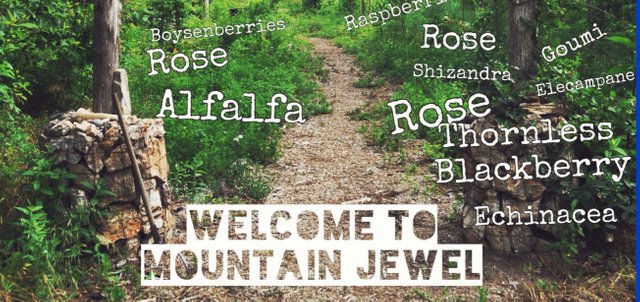
We've been wanting to share the details of what our gardens are all about.
Our approach is based on what we've observed and is more focused on perennials than annuals. Our strategies are organic and fluid (in content and approach) and are therefore not cut and dry. In this post we'll offer a little peek into what is growing at Mountain Jewel.
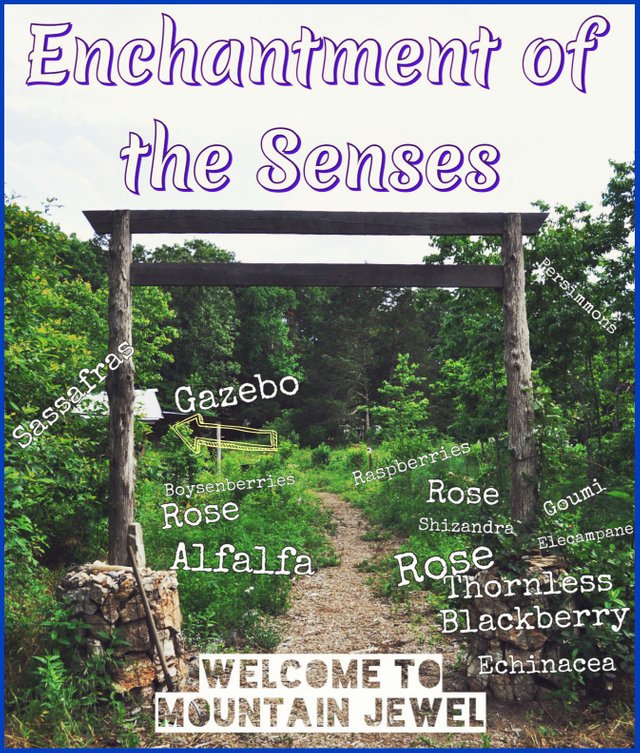
This is the entrance and I call it the Enchantment of the Senses garden. As you walk in, your senses are engaged as you're smelling roses, eating berries, being dazzled by flowers, watching insects interact with plants, etc. Our goal here was to create a welcoming entrance to our property and to entice further exploration.
Maps
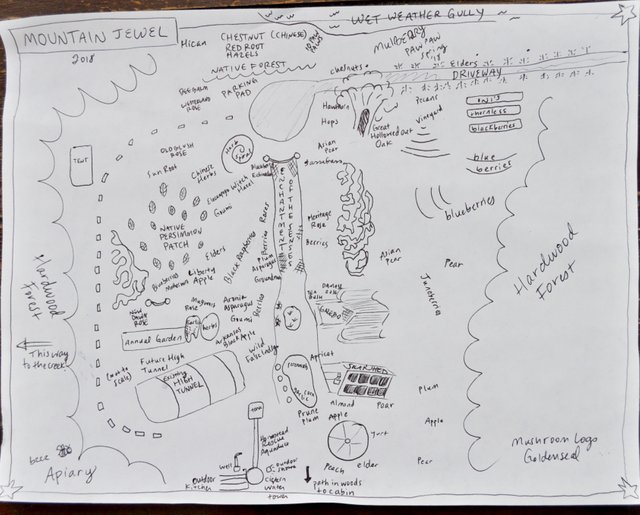
Today we'll focus on this 2 acre part of the homestead:
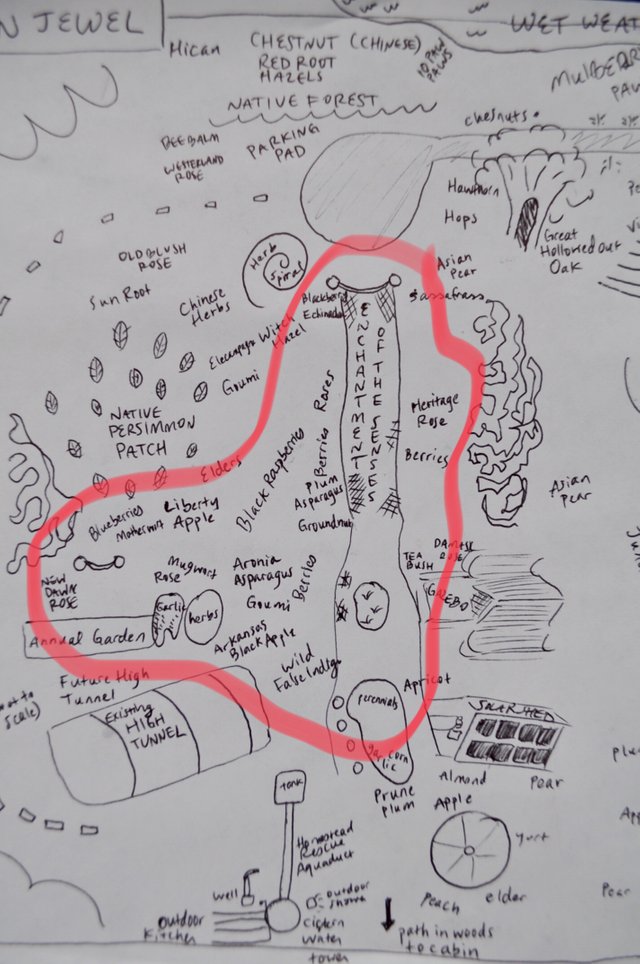
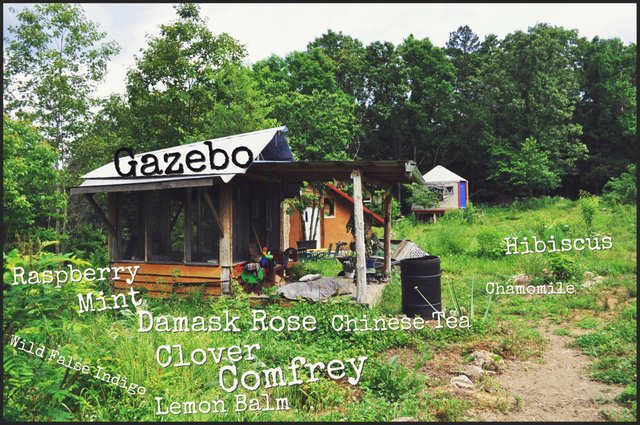
"Raw Piece of Land"
When we moved here there was already a driveway and a roughly 3 acre clearing that had been established by previous owners who never ended up living here.
These two things were a blessing and really guided our methodology. I would put it about 10 years ago that the land was cleared based on tree ring counts.
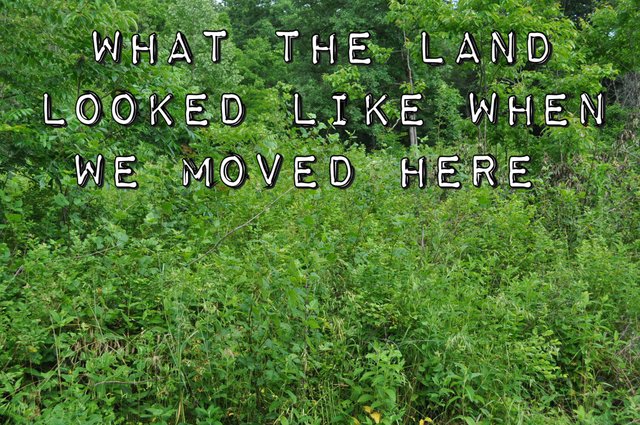
This set the stage for ecological succession, and we stepped in past the "old field" stage and arrived during the pioneering phase of transition to mixed hardwood forest. This means that there was plenty of brushy understory growth (aromatic sumac, buckbrush, blackberries etc..) along with a developing canopy of oak, hickory, cedar, black locust, persimmons, paw paw etc..).
We stepped into this transitional ecosystem as ecological influencers. This first year was a year of observation, clearing and setting up foundational systems, so we didn't plant much.
Getting Started
We began our efforts in first clearing the massive tangle of brushy growth and saplings.
This organic matter was turned into either ash or biochar and has helped amend the nutrient poor rocky soil we are tending in the Ozark Mountains.
Through the use of mattock, grub hoe, chainsaw, pruners, fire and goats we managed to establish pathways and areas of cultivation. We have used a small lawn tractor on a few occasions to plow out rocks and roots, but the majority of the labor is done by human power.
Our first annual garden beds were laboriously double dug meaning that the bed was dug to about 2 shovel depths.
This was WAY more work than I have ever put into beds as the amount of rocks was astounding. Our soils are classified as extremely gravely silty loam and are low in Nitrogen, Potassium and organic matter.
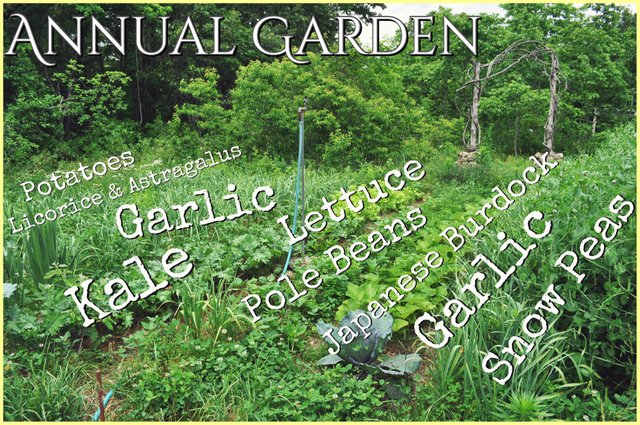
Part of our 2018 Annual Garden
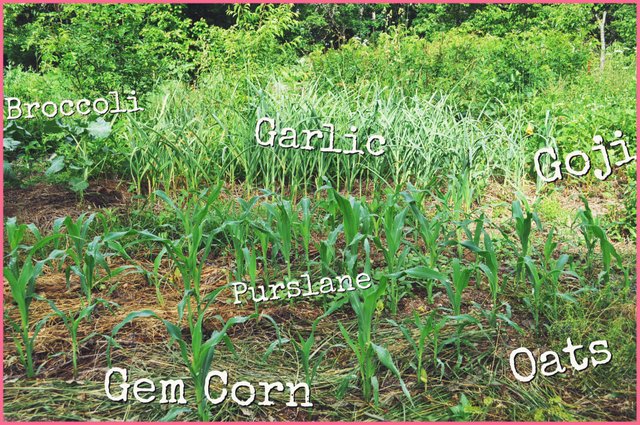
Section of annuals mixed in a Perennial Bed
Our first step was removing rocks, trees, stumps and roots. We amended with ash, horse manure, lime and biochar before our first planting of crops. We have continued this process more or less for all annual planting and have since incorporated compost and worm castings into the mix along with compost teas.
Placement in time and space
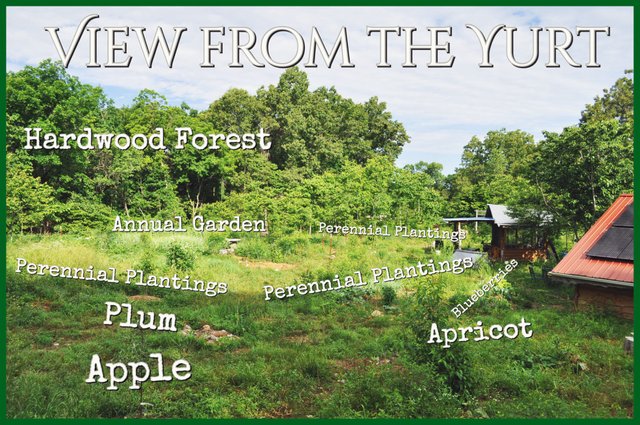
A slice of some diversified plantings. The trees were put in last fall and the blueberries this spring. Both will fill the space out in years to come as much of the area is left for the plants to grow into, considering time and space. We laid it out to take advantage of the slope through planting on contour and creating a catchment swale and berm.
As I mentioned earlier our main focus is on perennials, and the establishment is less immediately labor intensive than for that of annuals.
We have planted hundreds of trees in Zones 2, 3 and 4 of our homestead. This refers to the basic zoning principle practiced in Permaculture where the areas that receive the most time, attention and care are zone 0 (self and home) and zone 1 (kitchen gardens, herbs, greenhouse, etc) extending through zone 5 that is said to be let alone as "wild" space.
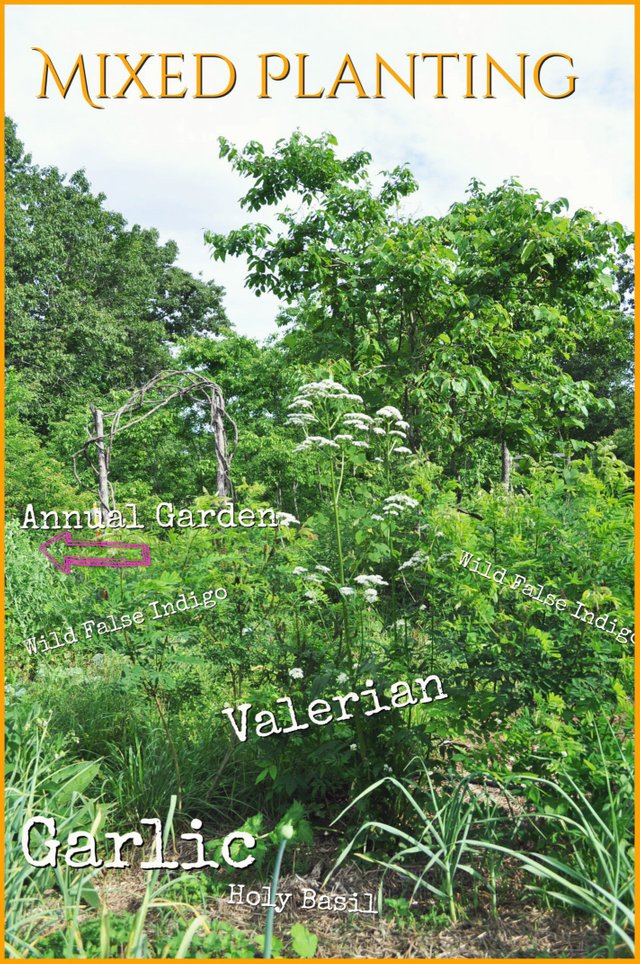
Here we see a small area filled with both annuals and perennials. There is a goumi just outside the frame and rose out of sight. What is noteworthy here is that the false wild indigos act as nitrogen fixing shrubs that produce gorgeous flowers and plenty of biomass. The valerian is used for medicine as is the garlic and holy basil. This a good example of long lived species mixed in with volunteers (holy basil) and annual crops (garlic). This level of diversity adds complexity to the system and bolsters resiliency.
There is a lot that isn't apparent yet as much of what we have planted is still establishing and quite small. We have planted a great deal of bare root trees and shrubs and some are still in their first year. With many of these perennials they go through stages during their establishment.
A popular saying is that they Sleep, Creep then Leap.
This is showing to be true some of the plants we put in the ground are not showing vigorous growth until the second season and much is yet to be seen. We are still waiting for many of our babies to Leap into their full potential of growth.
As we began our journey we walked the land a lot and sometimes thought long and hard about placement, other times worked more on intuition. Much of what we're doing is looking into the future and anticipating how the system will evolve throughout time and space.
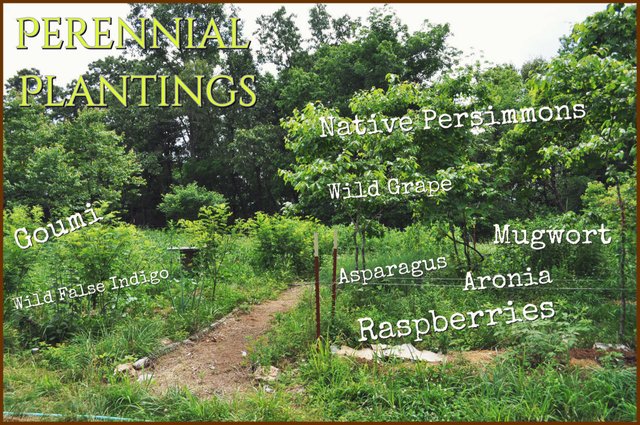
Here's a neat interface of wild and cultivated. The wild grape is climbing the persimmon which reminds us to think in 3 dimensions, while the shade creates a diversity of microclimates. The species we've selected here are all hardy and both the false wild indigo and Goumi fix nitrogen. Not featured here, but present is an understory of clover and mint.
How we've laid things out
We first started our layout by selecting the flattest area that received full sun and started to develop annual garden beds.
This was the start of something long awaited for us both: tending and establishing our own gardens. We cleared 3 large trees that cast quite a bit of shade on the main area before starting to establish any beds. More clearing will come in future years as the need arises.
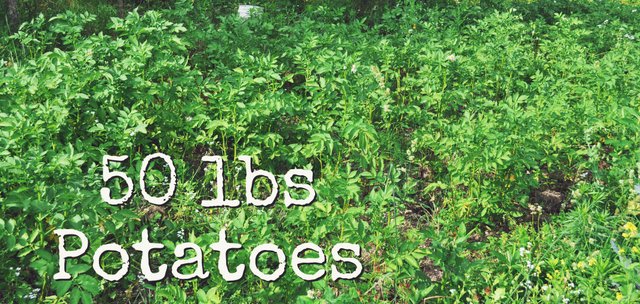
Potatoes are a reliable staple for us that are not fussy, store well and can be enjoyed in many ways. This year we planted almost double what we did last year and managed to get 50 pounds of seed potatoes in the ground this spring. We won’t do sweet potatoes this year in lieu of this.
Water
We get over 50 inches of rain on average per year and the first year we relied heavily on rains to establish our plants.
We knew our well would be drilled during the first season and would be on the highest point of the property allowing for gravity to move water around the property.
This approach allows us to us gravity to feed our drip irrigation to the garden and opens up the potential for flood irrigation options in the future as well. This was a good place for us to start as it already had almost full sun (after the 3 trees went it was almost 100% sun) and didn't have as much clearing to be done. We also chose this area as it was fairly centrally located and flanked by our 2 major pathways and this encourages easy access and frequent visits and facilitates tending.
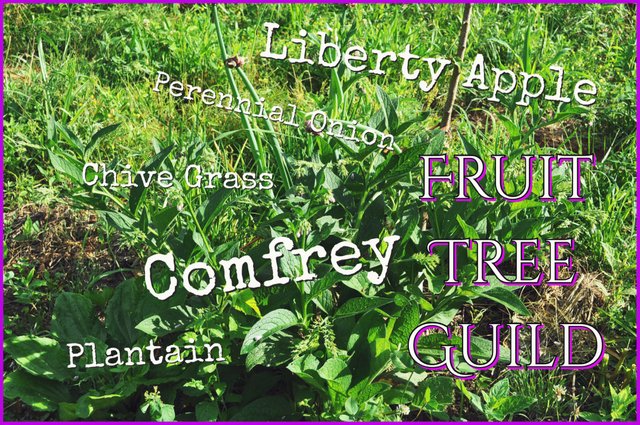
A good example of learning from nature and using guilds. These are essentially biological communities that work together to create harmony. In this case the central plant is a standard apple tree with a variety of herbs acting as supportive team members. The comfrey and plantain are dynamic accumulators meaning they actively pull up minerals, making them accessible for the apple to utilize. They are also cut and used as mulch. The onions and chive grass provide food for us and also help to repel pests due to their strong scent. They are all working together to create more abudance.
What we plant
Our first serious planting was sweet potatoes as they thrive in the heat, shade the soil and are tolerant of poor soil conditions. Following this was garlic.
During this first season we worked on clearing areas and assessing and analyzing the landscape. We kept finding exciting niches of plants waiting to be discovered. A paw paw grove here, another thicket of persimmons, a mulberry here and there, elderberries and wild blueberries, not to mention a host of wildflowers and medicinals.
This informed our planting choices a great deal as we based our species on the wild variety of plants already present. Our choice was to select similar of improved version of the wild plants with the intention of creating a thriving, diverse and productive food forest.
Soil
We introduce quite a few nitrogen fixers and fertility plants including wild false indigo, alfalfa and red, white and ladino clover. These plant not only will gaps in the system where we created bare soil, but also fix nitrogen, act as living mulch and are used mulch in the chop and drop method.
Paying attention to native plants
We noticed oodles of wild blackberries, so we established several patches of thornless blackberries for higher productivity without the the thorns. We planted paw paw cultivars to increase yields and quality of fruits, planted new patches using inexpensive state nursery stock and grafted onto existing trees. We have also planted other hardy fruits like serviceberries, asian pear and elders. We have taken what was here to begin with and begun to influence a higher diversity and introduced selective genetics.
We are evolving with the land as the process of establishing plants unfolds.
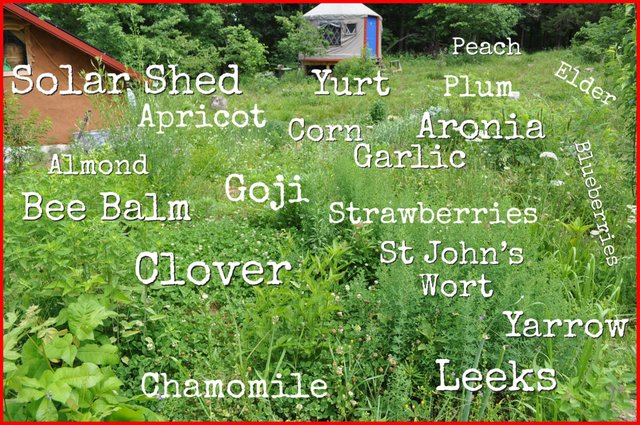
As you can see in the pictures, we've been quite busy over the past few years. This is a dream we have both had before we even met so we're happy to be a part of its unfolding!
Not mentioned are the tomatoes, peppers and ashwagandha in the High Tunnel and a few other annual/perennial mixed beds. For another day!
This is an entry into Garden Layout Contest
Interested in seeing your Existing Garden Layout - or Plans for a Future Garden. It would be interesting to know why you grow specific plants. Are the plants planted where they are for a specific reason?
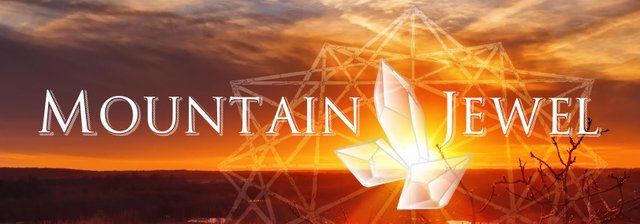
banner by @radicalunicorn

this post was written by a passenger of the #ecoTrain. Check the tag often for more inspiration!
ok....just WOW!!!!! mind and heart = blown!!!!! i LOVE maps!!! especially maps..with red lines...lol. my first love of this type of map...was at the beginning of "Raiders of the Lost Ark".....the map...showing his travels....via airplane...to the far east. my goodness you two!!!!! just WOW!!!!!!!! i could happily explore your little paradise for weeks!!!!!!! this is one of my favorite posts yet!!!! completely inspired beyond ALL WORDS! re steemed!!!
.... Speechless. You're enthusiasm is making me blush... Touching word indeed. As always big love for all your support, kind words and encouragement.
There's a lot to explore on our land, and a lot more maps to draw. I LOVE the map you're speaking of too. I've been meaning to get the compass and 100' tape out and accurately place all that we've put into motion, but it never quite seems to happen. When I do I'll have to make one version that is charred on the edges and tea stained, just like i made in grade 4...
The cool part is WE are still exploring our land. What we love about doing everything by hand is the details that we notice. A new N-fixer here, a unique shrub there, a baby walnut tree we never saw before. Theres so much layering that the ecosystem has created and we LOVE that we keep finding more fruit and nut trees. Just found 2 mulberries close to the main zone that I'd missed so far. This is fuel for us to keep planting analogues of the wild versions and peace of mind that we haven't amended any of our trees beyond mulching.
Can't wait till we get more bee colonies here and all the trees are in full bloom a-buzzing with the sweet winged ones. That'll have to make it onto the map too ;)
Thank you for the information and inspiration! I will re-read this post many times.
What a wonderful permaculture food forest you have!! The diversity on your homestead is impressive. Thank you for sharing the nitrogen fixers you planted. I have not heard of wild false indigo and did not know it can fix nitrogen. Looks like it has beautiful flowers. You two are very knowledgeable on permaculture. Love the way you explained the reasons for your plantings and your selections of plants for tree guild. Such a detailed post. Truly enjoy reading it. Great job! Resteemed.
This means a lot coming from you, THANKS. Diversity is definitely the name of the game here. False wild indigo has quickly become of our favorites, so regal and definitely established itself well. We're still itching to get Siberian pea shrub and look into other great perennial N fixers.
Happy the explanation was helpful, we are but a part of a long line of people much smarter and more experienced than ourselves, we're just scratching the tip of the iceberg here.
Stoked you enjoyed it and we both appreciated the resteem.
Thanks for giving us a beautiful visual tour. Such an inspiration! Can you tell me more about your fruit Guild? Do you always plant perennial onion, chive grass, plantain, and comfrey with your fruit trees? We have a bunch of fruit trees in pots waiting to get in the ground. I'd like to try the guild method but am just getting into the learning curve of it.
Great that you were inspired by this. We have gleaned much inspiration from other projects that have fueled our passion and knowledge in years past. As for guilds, it is a basic framework. We established this guild based on what plants we had on hand. We are slowly building up our stocks and will plant out the rest of the fruit trees in time. As a general guideline though, comfrey is AWESOME! We will keep spreading it (it is VERY vigorous, has profuse growth, is edible, is a great medicine, accumulates nutrients and provides pollen).
To keep it simple a guild will often have one or more of each: N-fixers,(not seen here are clover and annual peas), Dynamic accumulators, insectary plants (insect forage) and pest confuser (herbs, allium, etc). Hope this helps. If you're into diving deeper, I would highly recommend "Gaia's Garden" by Toby Hemenway. We will make a post focusing on guild soon, so stay tuned.
Wow! @mountainjewel! y'all are freakin killing it. Love y'alls garden layout! I'm in the middle of my plan to escape my 9-5 and move out of the city to a 4.5 acre piece of land that I'm building into a permaculture farm. You guys are so inspirational and informative. I eat up your posts, thank you so much for sharing!
ahhh, you're so kind. We have literally killed quite a few plant along the way too...
YAY, escaping the 9-5! Thats a bold move and I wish you all the best. Just know that life on the homestead can end up being 24/7 at times. I'm sure you're up for it though ;)
Where's the property you'll be moving to?
Happy that you get so much out of our posts, and super stoked to be hearing this as it feeds the fires of inspiration for us!
Thanks again for your kind and enthusiast words!
Yeah @mountainjewel! Love you guys and your work :) I know....just getting my first water catchment installed was a huge effort. Right now I'm just taking weekends and planning out projects I can accomplish each weekend. My property is in Crane Hill AL pretty close to Smith lake.
I am reading and all I can think of is that I will never be able to make something like that. It's just awesome, you guys are totally immersed in this. I bet you had your share of difficulties also, but the results are outstanding.
Well, you totally could do it if you committed yourself, not saying you should though... It's within all of us to dream big and make those dreams reality. We had some tough times for sure, especially the second fall when we came back from a trip to find out yurt was moldy and unlivable! camping in the winter is fun and all, but it got old pretty fast!
It's all worth it to be living our dream though.
This is a really well thought out post, not mention a wonderful garden! I found it easy to read and follow and the photos were a great asset.
I really liked seeing all the different things you 2 have added over the years.
I am curious how the alliums do with the other plants so close. Do the garlic get large bulbs? Do the leeks get nice thick stems?
I find your garden really fascinating, but it would be really overwhelming for me if it were mine! My Lyme brain does better with simple and straight, too much different input at once and it goes on strike! That's why your post was impressive, even I could follow it!
Great feedback. Wren is the photo wizard and she continues to amaze me with her skills.
The leeks in the high tunnel were plant last fall and most developed robust stalks. The garlic is planted at 4-6" and we found this to be a wee bit close at times, but still get decent head development. Our issue has been getting enough land into production to plant all the seed stock we had, so we opted for closer spacing. This is our first year planting out the pathways with spuds as the beds kept eroding into the path, so Wren suggested we plant them out. We'll let you know how this year's harvest goes.
Don't be fooled we get overwhelmed at times too! Our style is indeed more organic than linear, but there is a time and place for straight(ish) rows. Glad my meandering thoughts could be clear enough to be understood to you. Thanks for commenting.
You guys are doing great work out in the world (I believe permaculture is THE solution to climate change!) and here on steemit, and this post is no exception. Keep it up!
thank you so much @natureofbeing. means a lot coming from you <3 we believe Permaculture is THE solution too!!!!!
What a story you have. Patience and planning. You are an inspiration to all that are considering or dreaming of their own homestead. Or smaller projects.
Patience and planning indeed, not to mention buckets of sweat! Thanks for your kind words. This is why we share; to inspire, connect and show just what can be done if we ally with nature. I feel the passion and inspiration behind projects is what really makes it happen, the details come later.
Thanks for sharing, truly inspiring to see you put a plan into action and watch it become fruitful. Keep up the good work, all the best to you, JerryT.
Thanks for the support and appreciation. It is an honor to share our journey we're glad it is inspiring to you ;)